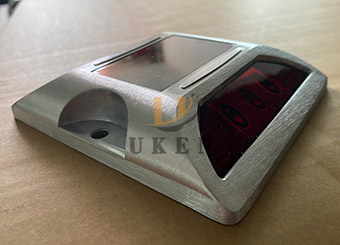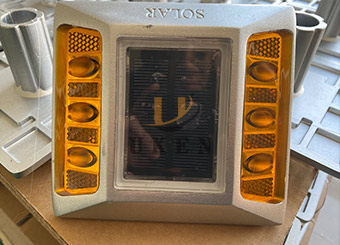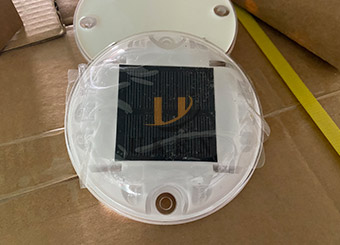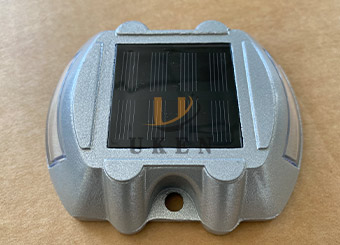Solar road stud lights play an important role in road safety and traffic guidance, they can provide drivers with clear road guidance at night or in bad weather, effectively reducing the probability of traffic accidents. Proper maintenance is the key to ensure the continued stable operation of solar spike lights. In this article, we will provide you with a comprehensive maintenance guide to help you extend the service life and optimise the performance of solar road stud lights. Next, we will start from the maintenance preparation, daily cleaning, parts inspection, troubleshooting and other aspects of the detailed introduction.
In the solar road stud light maintenance, personal safety protection is essential. Maintenance personnel should wear gloves and goggles and other protective gear. Gloves can avoid hand scratches by sharp parts during operation, and goggles can prevent dust, debris, etc. from entering the eyes, reducing the risk of potential injury.
Meanwhile, when carrying out maintenance work on roads or near traffic areas, make sure to set up standardised warning signs and safety barriers. For example, place reflective cones, set up warning signs, delineate a clear work area, so as to remind passing vehicles and pedestrians to pay attention to avoid, to protect the personal safety of maintenance personnel.
Cleaning solar road stud lights requires a soft bristle brush, microfibre cloth and a mild detergent. The soft bristle brush can gently brush away dust and dirt on the solar panel and housing without scratching the surface; the microfibre cloth can be used to wipe away water stains and stubborn stains; and the mild detergent helps to remove oil stains and dirt that are difficult to clean.
And a multimeter, screwdriver and magnifying glass are common tools used during component inspections. Multimeter is used to test the performance of electrical components, such as measuring battery voltage, solar panel output current, etc.; screwdriver is used to open the spiked light shell, to facilitate the inspection of the internal wiring and components; magnifying glass can help the maintenance staff to more carefully see whether there is a slight crack, damage or corrosion of the components.
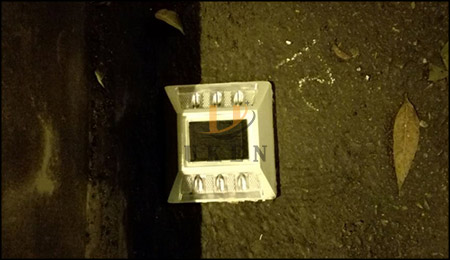
solar panel cleaning
The cleaning frequency of solar panels depends on the actual environment. In dusty areas, such as roads near mining areas and dry and sandy areas, it is recommended to clean them once every 1-2 weeks; while in less dusty areas with relatively clean environment, it is sufficient to clean them once a month.
When cleaning, use a soft-bristle brush to gently brush away dust and debris from the surface in one direction, avoiding back-and-forth friction and damage to the board surface. For stubborn stains, dilute a mild detergent and gently brush with a soft-bristle brush dipped in the solution, then rinse with clean water and finally dry with a microfiber cloth. Keeping the surface of the solar panel clean maximises its efficiency in absorbing sunlight and ensures efficient charging of the internal battery.
The shell of the road stud light will be stained with mud, dirt and other pollutants due to long-term exposure to the outdoors. When cleaning, you can use a damp cloth with a mild detergent to wipe it, and for the dirt in the crevices, you can use a soft brush to clean it carefully.
The cleaning of the reflective surface is equally important, which directly affects the guiding effect of the spike light in low-light conditions. Use a clean soft cloth to gently wipe the reflective surface, remove surface dust and stains, do not use rough tools, so as not to scratch the reflective coating, affecting the reflective performance.
Daily visual inspection of solar panels is required to observe whether there are cracks, damages or discolouration on the panel surface. Tiny cracks may gradually expand over time, affecting the power generation efficiency of the solar panel; discoloured areas may indicate internal short-circuits and other problems, all of which need to be dealt with in a timely manner.
In addition, a multimeter can be used to test the power generation efficiency of solar panels. Under sufficient light conditions, measure the output voltage and current of the solar panel and compare them with the standard parameters in the product manual. If the measured values are significantly lower than the standard values, it means that the solar panel may have performance degradation problems and need to be further checked or replaced.
Regularly check the voltage and charging status of the battery to judge the health of the battery. Under normal circumstances, the battery voltage should be stable within a certain range, if the voltage fluctuation is large or significantly lower than the rated value, it may mean that the battery failure. At the same time, observe the appearance of the battery, if you find the battery bulging, leakage, etc., indicating that the battery has been seriously damaged, need to be replaced immediately.
When replacing the battery, you should use the same specification as the original model and install it according to the correct operation method. For used batteries, should not be discarded, need to be properly disposed of in accordance with local environmental regulations, to avoid pollution of the environment.
Check whether the LED lights are working properly, at night or in a low-light environment, to observe whether the lights are stable, no flicker, dark or no light. If there is any abnormality, the LED light itself may be damaged, or it may be a circuit connection problem.
When checking the circuit part, see whether the line connection is firm, there is no loose, off phenomenon; check whether there is corrosion and damage to the line; check whether the components on the circuit board are burnt, deformation and other issues. For loose connections, need to re-tighten; for damaged lines and components, should be replaced and repaired in a timely manner.

There are a variety of reasons that lead to insufficient charging of solar road stud lights. Solar panels are blocked by trees, buildings, etc., which will reduce the light it receives, thus affecting the charging efficiency; continuous rainy weather or too short a period of light will also cause inadequate charging; in addition, charging controller failure may also lead to charging anomalies.
To address these issues, if there is shade, consider adjusting the installation position of the road stud light to ensure that the solar panel can fully receive sunlight; in dusty or cloudy weather frequent areas, increase the frequency of solar panel cleaning; if it is determined to be a charge controller failure, it is necessary to replace the controller with a new one.
Poor lighting may be caused by damaged LEDs, low battery or faulty circuit connections. If the LED lights are damaged, replace the LED beads with the same type; if the battery is low, check whether the charging system is working properly and replace the battery if necessary; if there are connection problems in the circuit, check the lines carefully and repair loose or damaged connections.
When found inside the spike light moisture condensation, rust and corrosion of metal parts, indicating that there may be water problems. At this time, you need to check whether the shell sealing tape aging, cracking, shell seams whether there are gaps. For minor water ingress, the spike light can be disassembled, dry the internal moisture with a dry cloth, and placed in a ventilated dry place to dry; if the sealing tape is damaged, you need to replace the new tape and re-seal the shell to prevent water ingress again.
In spring and summer, there are more sand and rain, and the road is dusty, so the cleaning frequency of solar panels and shells should be increased. At the same time, after heavy rain and windy weather, timely check whether the road stud light is damaged due to bad weather, such as checking whether there are cracks in the shell and whether the solar panel is loose.
In autumn and winter, need to make good preparation for the spike light against the cold. In areas with low temperatures, check whether the insulation measures of the battery are in place, to avoid the battery due to low temperature affects the performance; after a heavy snowfall, clean up the snow on the surface of the stud light in a timely manner to ensure its normal operation.
A comprehensive inspection should be carried out once a year, covering all components such as solar panels, batteries, LED lights, circuits, etc., to assess the overall performance of the spike light, and identify potential problems and deal with them in a timely manner.
According to the service life of each component, formulate a replacement plan. For example, the general service life of the solar panel is 25 – 30 years, but the actual use may be due to environmental factors early aging; battery life is usually 3 – 5 years, after reaching the service life, even if there is no obvious damage to the appearance, should be replaced in a timely manner, in order to ensure the normal operation of the spike light.
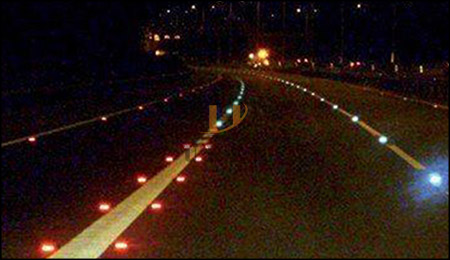
Detailed records of maintenance activities help track the performance changes of solar stud lights. By comparing the maintenance records of different periods, you can analyse the wear and tear of components and the overall performance trend of the spike light, and discover potential failure hazards in a timely manner.
Meanwhile, complete maintenance records can play an important role during the product warranty period. When quality problems occur, the records can be used to apply for warranty service from the manufacturer. In addition, standardised maintenance records are also an important proof of meeting the requirements of relevant safety and maintenance standards.
Maintenance records should contain information such as the date of maintenance, specific maintenance tasks (e.g. cleaning, parts inspection, replacement, etc.), names of parts inspected and replaced, problems found during maintenance and solutions.
It should also record the data related to the performance of the spike light, such as the battery voltage, LED light brightness, solar panel output power at each inspection. These data can intuitively reflect the working status of the spike light, for subsequent maintenance and troubleshooting to provide an important reference.
Do a good job of solar spike light maintenance, need to pay attention to cleaning, inspection, troubleshooting, maintenance cycle and other aspects. Through regular and standardised maintenance, not only can you extend the service life of the spike light, but also effectively improve road safety. We hope this guide can help you better maintain solar stud lights, if you have any questions in the maintenance process, please feel free to communicate with us.
